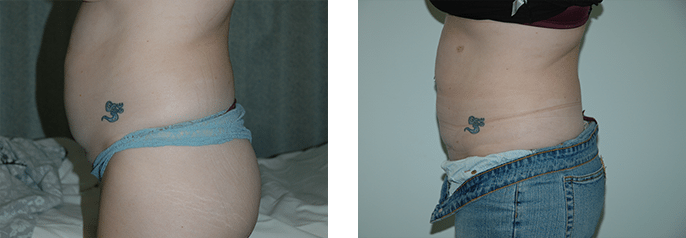Abdominoplasty, involves the removal of excess skin and fat from the middle and lower abdomen. It addresses protruding fat, loose skin and also laxity of the abdominal wall muscles.
Typical patients have often experienced extreme weight loss or pregnancy and wish to create a flatter stomach area.
- Flatter stomach
- Tighten the abdominal muscles
- Remove excess fat and tighten the skin

Book your consultation
At a Glance
Abdominoplasty Procedure
The surgery is designed to remove excess skin and fat from the lower abdomen and in some circumstances, to tighten the abdominal muscles.
Abdominoplasty Surgery Duration
Dependent on individual requirements and varying patients’ circumstances the procedure can take anywhere from 2-5 hours to complete.
In/Outpatient
This is dependant on your individual circumstances and extent of surgery. The procedure is generally performed under general anaesthetic.
Abdominoplasty Side Effects
Temporary pain, swelling, soreness, numbness and bruising may occur. Tiredness can also be expected for several weeks to months.
Abdominoplasty Surgery Risks
Blood clots, infections, bleeding under the skin flap can be expected post-abdominoplasty. Poor healing resulting in conspicuous scarring, skin loss and the need for further operations may occur. To read more about surgical risks please ‘click here’.
Abdominoplasty Recovery
Most patients are back at work within 2—4 weeks. Strenuous activity should be avoided for at least 4—6 weeks. The fading of scars will be seen in 3 months to 2 years.
Abdominoplasty Before and Afters


Abdominoplasty is a cosmetic procedure that involves the removal of excess loose skin and fat from around the abdomen area and may need tightening of the muscles in some cases.
An initial consultation with Dr John Flynn will be the first step to prepare for abdominoplasty.
During your consultation, the following surgical factor will be addressed and discussed with you. Dr Flynn will take the time to explain to you every aspect of surgery so you can make a well-informed decision moving forward.
- The procedure
- The type of anaesthesia to be used
- The risks and limitations
- Costs involved
- Required medications
- Your expectations and goals
- The steps to take prior to the operation
Dr Flynn will also discuss your medical history to help formulate the most suitable treatment plan. It is important to fully disclose any health problems you may have had, as some may interfere with surgery, anaesthesia and aftercare.
Prior to surgery, you should properly prepare by packing loose and comfortable clothing to wear after the procedure, getting adequate sleep the night before, and arranging a ride home. If you are undergoing general anaesthesia, you will be required to abstain from eating or drinking for at least six hours before surgery (this helps prevent an upset stomach while under anaesthesia).
Anyone who is about to undergo cosmetic surgery needs to be physically, mentally and emotionally prepared for the changes that are about to take place. We encourage patients to have a support system, whether a partner or family.
Following your surgery you will be required to wear a compression garment up to 6 weeks. You may find it difficult to walk with your back straight initially but this will improve over a few days. Pain and discomfort vary depending on the individual but this is to be expected over the first few days after which the symptoms will improve.
You will be given pain medication post-operatively. You will however require some help at home in the early stages and must avoid heavy lifting and straining for six weeks. Returning to work or normal activities will be about 2—4 weeks.
Every surgical or medical procedure involves a certain amount of risk. Cosmetic procedures have a good safety profile but despite the highest standards of surgical practice, complications can still occur.
The most effective way to minimise the risks involved is to undergo a thorough physical examination with your doctor prior to surgery.
Although complications are rare, they can include infection, nerve damage, blood clotting, fluid loss and negative reactions to anaesthesia.
Infection is uncommon but if it does occur it can be serious and requires proper attention and antibiotics. Major infections can be life threatening. Patients are normally given antibiotic cover for the procedure to minimize this risk.
A change in shape of the navel (belly button) may occur and sometimes there can be some unevenness of the scar or of the abdomen.
General anaesthetic itself carries a risk, including death, and any medical conditions and medications might affect the anaesthetic and are important to identify to the staff.
Less severe liposuction risks include scarring, loss of sensation in and near the treated area, as well as skin discolouration in the treated area. Diabetes, poor circulation, heart, lung or liver disease, smoking or a family history of blood clots may also increase the risk of complications.
Contact your doctor if you experience any concerns or problems following liposuction. These may include:
- Nausea
- Fever or chills
- Heavy bleeding or oozing from incision sites
- Increased swelling around the surgery sites
- Increasing pain
- Redness around incision sites that is spreading.
General dissatisfaction can be minimised by fully understanding the risks and benefits associated with your chosen surgery and having realistic expectations.
To maximise the success of surgery and minimise the potential risk of complications, always follow your doctor’s instructions for surgical preparation and post-operative care.